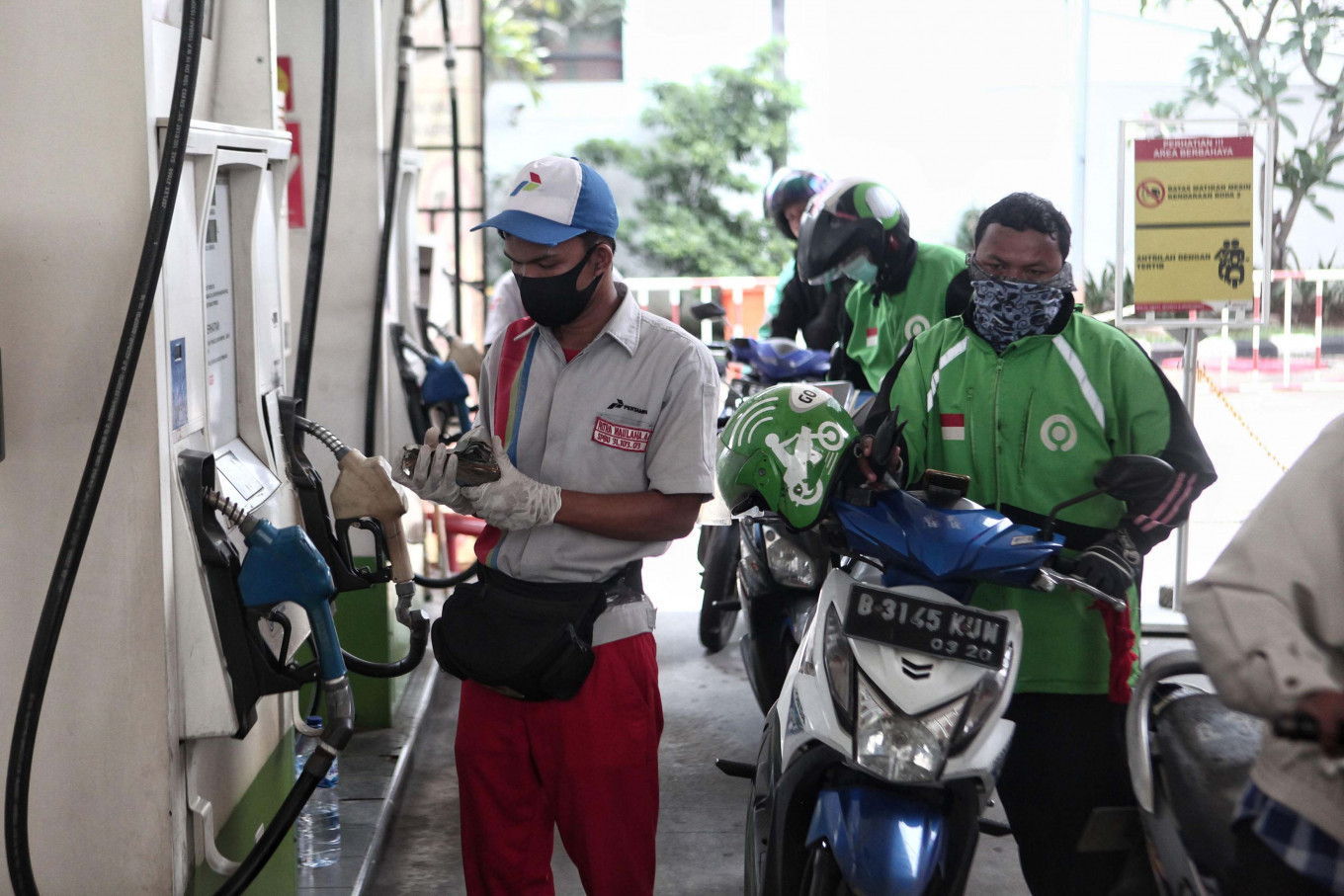Popular Reads
Top Results
Can't find what you're looking for?
View all search resultsPopular Reads
Top Results
Can't find what you're looking for?
View all search resultsFor first time ever, fuel consumption falls instead of rising during Idul Fitri
Change text size
Gift Premium Articles
to Anyone
 Online motorcycle taxi drivers refuel at a gas station in Cikini, Jakarta, on April 14. Indonesia’s fuel consumption was down 31.2 percent during this year’s Idul Fitri compared to normal days, falling for the first time ever, as the country banned the traditional holiday exodus to contain the COVID-19 outbreak. (JP/Seto Wardhana )
Online motorcycle taxi drivers refuel at a gas station in Cikini, Jakarta, on April 14. Indonesia’s fuel consumption was down 31.2 percent during this year’s Idul Fitri compared to normal days, falling for the first time ever, as the country banned the traditional holiday exodus to contain the COVID-19 outbreak. (JP/Seto Wardhana )
N
ationwide fuel consumption during this year’s Idul Fitri period was 31.2 percent below the normal level as the government had banned the traditional mudik (exodus) to contain the COVID-19 outbreak.
Fuel consumption averaged 106.933 kiloliters per day in the Idul Fitri week, down from 155,377 kl per day in January and February, the months before Indonesia confirmed its first COVID-19 cases, which later prompted large-scale social restrictions (PSBB) that shut offices, factories and schools and limited people’s movements, according to an official report obtained by The Jakarta Post.
Aviation fuel consumption saw the sharpest drop, falling 86 percent below the normal volume, while diesel decreased 29 percent and gasoline and kerosene use dropped 21 percent and 9 percent, respectively.
“This is the first time we have seen such sharp drops. Normally, fuel consumption tends to rise [during Idul Fitri],” energy economist Fahmy Radhi of Gadjah Mada University told the Post on Thursday.
“This is the first time it went down due to the mobility restrictions,” said Downstream Oil and Gas Regulatory Agency (BPH Migas) oil director Alfon Simanjuntak, also on Thursday.
Indonesia’s fuel consumption normally spikes in the week leading up to Idul Fitri as millions of city dwellers, especially from Jakarta, flock to their hometowns and home villages for the traditional exodus, the largest mass movement each year.
This year, however, the government banned the mudik to contain the coronavirus, albeit with exemptions subject to certain conditions.
Data from the Indonesia National Air Carriers Association (INACA) show that passenger traffic dropped 8.23 percent year-on-year (yoy) in the first quarter to 25.5 million people, and the figures for April and May are expected to show an even steeper decline.
Finance Minister Sri Mulyani Indrawati said earlier in May that only 70 flights were still operating at the time of a total of around 79,000 before the virus outbreak. She added that 12,703 domestic and international flights in the country had been canceled in the January-February period.
The pandemic, as of Thursday afternoon, has infected more than 24,500 people, almost 30 percent of whom live in Jakarta, official data show. As many as four provinces and 26 regencies/cities nationwide, including Greater Jakarta, Bandung in West Java and Surabaya in East Java, have imposed the partial lockdown as the number of positive cases continues to rise.
Meanwhile, cooking gas consumption remains high during the holiday period as people stay at home.
Liquefied petroleum gas (LGP) consumption was 14,404 metric tons per day this holiday, up 7 percent from normal days, according to a statement issued by state-owned oil and gas giant Pertamina on Wednesday. The spike is even sharper than its pre-holiday projection of a 5 percent increase.
Pertamina noted a rising trend in cooking gas consumption since March, when office workers and children, particularly those in large cities, began staying at home, as recommended by the government.
“We upped the distribution of 3-kilogram LPG canisters from seven days before Idul Fitri until one day before,” Pertamina spokeswoman Fajriyah Usman said on Wednesday.
Layoffs and working hour cuts have also driven many Indonesians to set up household bakeries and caterers to generate extra income.
However, domestic electricity consumption declined by 15.6 percent this holiday compared to normal days, according to data from the Energy and Mineral Resources (ESDM) Ministry.
Consumption peaked at 22,502 megawatts during the Idul Fitri holiday, said ministry spokesman Agung Pribadi. By comparison, average consumption was 26,650 MW, said the ministry’s electrification secretary, Munir Ahmad.
“We continue to ensure optimal access to electricity that is safe and secure,” Agung said on Wednesday.
He noted that, in Samarinda, East Kalimantan, electricity consumption was affected by severe flooding that forced PLN to shut down several substations. The floods ravaged from Saturday to Monday, which was Idul Fitri.
Sole electricity distributor PLN, a state-owned company, previously projected that consumption over the Idul Fitri period would not change much from normal levels, as many businesses and factories were already closed since March.
A PLN spokesperson did not reply to queries about the lower electricity consumption.









